Visit to download the full and correct content document: https://textbookfull.com/product/the-rough-guide-to-vietnam-9th-edition-rough-guides/
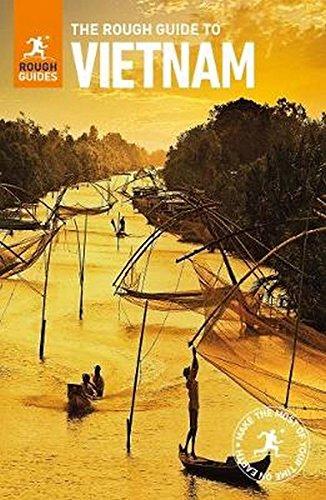
The Rough Guide to Vietnam 9th Edition Rough Guides
More products digital (pdf, epub, mobi) instant download maybe you interests ...

The Rough Guide to Brazil 9th Edition Rough Guides
https://textbookfull.com/product/the-rough-guide-to-brazil-9thedition-rough-guides/
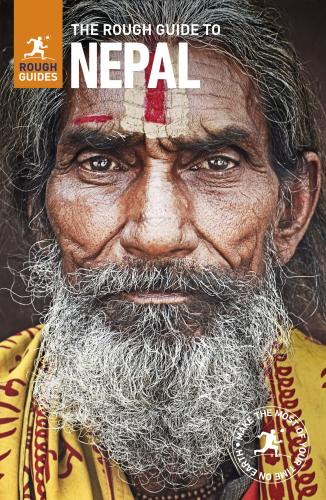
The Rough Guide to Nepal 9th ed 2018 Rough Guides
https://textbookfull.com/product/the-rough-guide-to-nepal-9thed-2018-rough-guides/

The Rough Guide to Bali and Lombok 9th Edition Rough Guides
https://textbookfull.com/product/the-rough-guide-to-bali-andlombok-9th-edition-rough-guides/
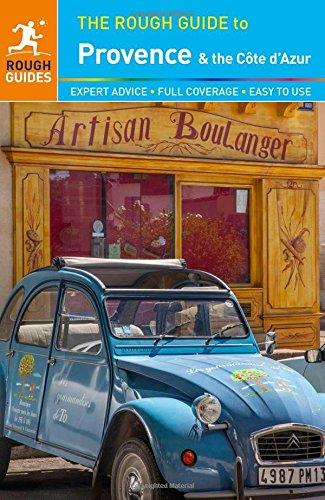
The Rough Guide to Provence Cote d Azur 9th Edition Rough Guides
https://textbookfull.com/product/the-rough-guide-to-provencecote-d-azur-9th-edition-rough-guides/
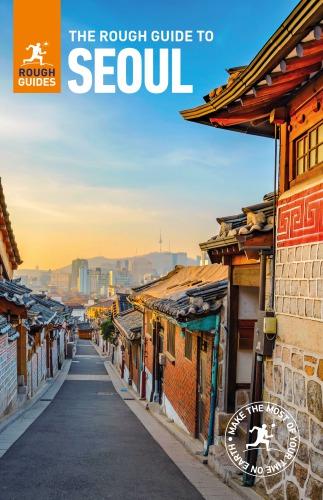
The Rough Guide to Seoul Rough Guides
https://textbookfull.com/product/the-rough-guide-to-seoul-roughguides/

The Rough Guide to the Netherlands Rough Guides
https://textbookfull.com/product/the-rough-guide-to-thenetherlands-rough-guides/

The Rough Guide to England 10th Edition Rough Guides
https://textbookfull.com/product/the-rough-guide-to-england-10thedition-rough-guides/
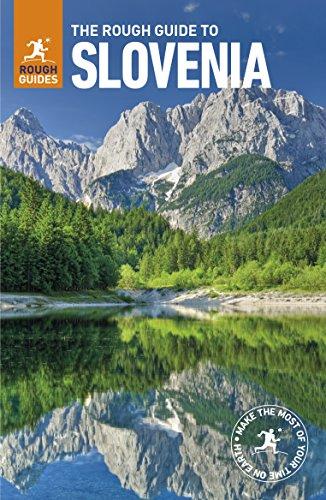
The Rough Guide to Slovenia 4th Edition Rough Guides
https://textbookfull.com/product/the-rough-guide-to-slovenia-4thedition-rough-guides/

The Rough Guide to Canada 1st Edition Rough Guides
https://textbookfull.com/product/the-rough-guide-to-canada-1stedition-rough-guides/
VIETNAM
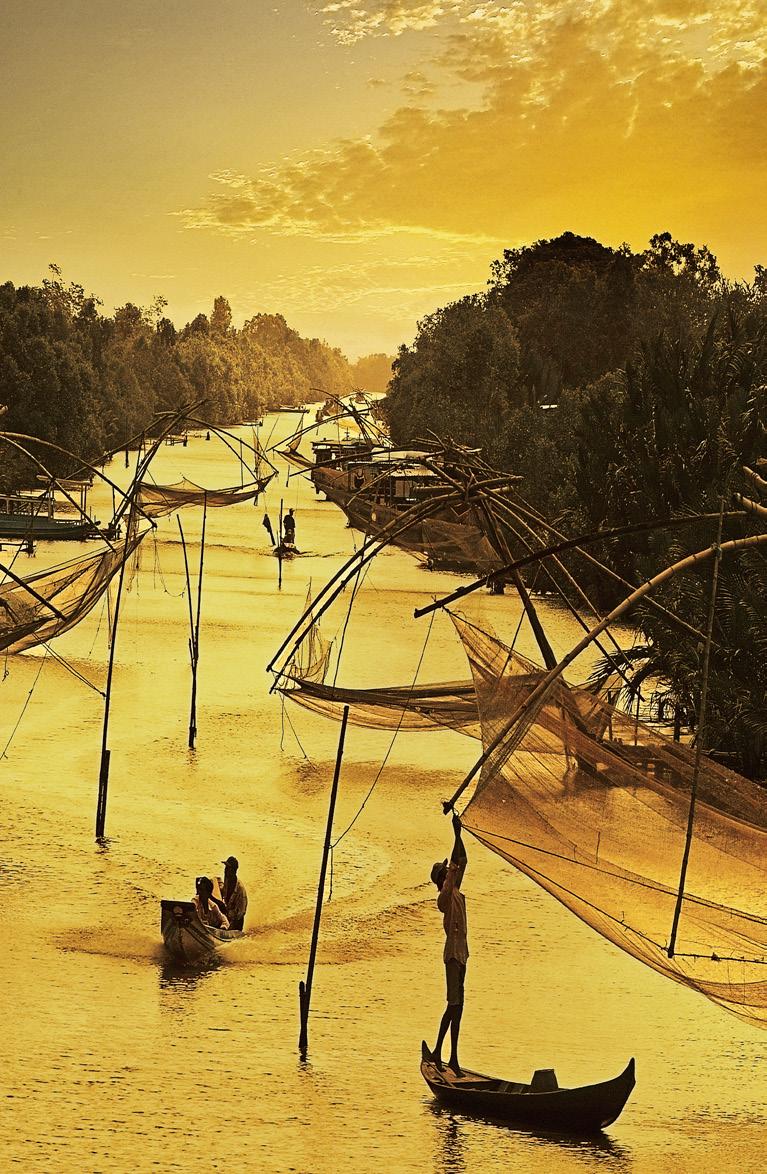
MAKETHE MOSTOF Y EMITRUO HTRAENO
THE
ROUGH GUIDE TO
INSIDE THIS BOOK
INTRODUCTION
Comprehensive, in-depth guide to Vietnam, with regional highlights and full-colour maps throughout
religion, ethnic cultures, environmental issues and music, plus recommended books and a useful language section
flagged up our favourite places – a perfectly sited hotel, an atmospheric café, a special restaurant –throughout the guide with the ★ symbol
This ninth edition published March 2018 Make the Most of Your Time on Earth at roughguides.com
What
BASICS Pre-departure
information
GUIDE
History,
5 4 3 2 6 1 7 8 Ca Mau Rach Gia Da Nang Hue Vinh Ninh Binh Haiphong Ha Long City Son La Dien Bien Phu Sa Pa Ha Giang Cao Bang My Tho Phan Rang Da Lat Nha Trang Buon Ma Thuot Pleiku Hoi An Can Tho Ho Chi Minh City Con Dao Archipelago Hainan Island Phu Quoc Island SOUTH CHINA SEA (EAST SEA) GULF OF THAILAND GULF OF TONKIN HANOI PHNOM PENH VIENTIANE CAMBODIA THAILAND CHINA L A O S N kilometres 0 200 Vietnam chapters 1 Ho Chi Minh City and around 2 The Mekong Delta 3 The central highlands 4 The southern coast 5 Central Vietnam 6 The northern coast 7 Hanoi and around 8 The far north We’ve
to see, what not to miss, itineraries and more
tips and practical
THE
CONTEXTS

ROUGH GUIDE TO
VIETNAM
ninth
This
edition updated by Ron Emmons, Rachel Mills and Martin Zatko
THE
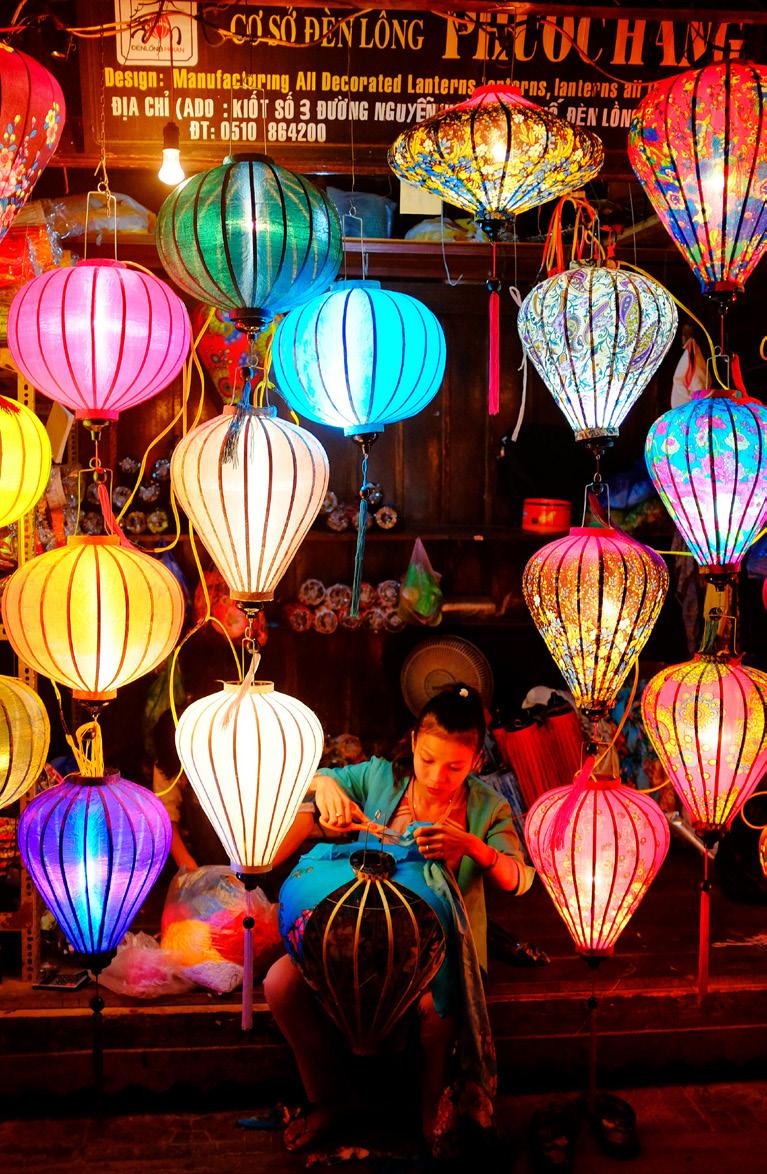
INTRODUCTION 3 Contents 1 Ho Chi Minh City and around 62 2 The Mekong Delta 110 3 The central highlands 166 4 The southern coast 198 5 Central Vietnam 240 6 The northern coast 302 7 Hanoi and around 340 8 The far north 390 Where to go 6 When to go 8 Author picks 11 Things not to miss 12 Itineraries 22 Getting there 25 Visas and entry requirements 28 Getting around 29 Accommodation 36 Food and drink 38 Health 45 The media 47 Crime and personal safety 48 Festivals and religious events 50 Sports and outdoor activities 52 Shopping 54 Travelling with children 55 Travel essentials 56 INTRODUCTION 4 BASICS 24 History 429 Religion and beliefs 452 Vietnam’s ethnic minorities 461 Environmental issues 470 Music and theatre 475 Books 480 Vietnam in the movies 485 Vietnamese 490 Glossary 495 SMALL PRINT & INDEX 497 CONTEXTS 428 THE GUIDE 62 OPPOSITE LANTERN-MAKER IN HOI AN PREVIOUS PAGE WOMAN COLLECTING WATER LILIES IN THE MEKONG DELTA

Vietnam Introduction to
One has to admire Vietnam – despite its tumultuous recent history, this resilient nation has bounced back to become a big-hitter on the Southeast Asian travel circuit. As one would expect from a country so long and skinny, there’s plenty of variety on offer – it’s a land of emerald paddy fields and white-sand beaches, full-tilt cities and venerable pagodas, vast caves, craggy mountains and friendly minority communities. Visitors are met with warmth, curiosity and a seemingly irrepressible desire to connect; add in some of the region’s most nuanced cuisine, and you’re onto a winner.
The reunification of North and South Vietnam in 1975 ended twenty years of bloody civil war, and was followed by a decade or so of hardline rule from which only the shake-up of doi moi – Vietnam’s equivalent of perestroika, beginning in 1986 – could awaken the country. This signalled a renaissance for Vietnam, and today a high fever of commerce grips the nation, seen in its flash new shopping malls and designer boutiques, and the hustle and bustle of its street markets.
There’s a marked difference between north and south, a deep psychological divide that was around long before the American War, and is engrained in Vietnamese culture. Northerners are considered reticent, thrifty, law-abiding and lacking the dynamism and entrepreneurial know-how of their supposedly more worldly wise southern compatriots. Not surprisingly, this is mirrored in the broader economy: the south is Vietnam’s growth engine, boasting lower unemployment and higher average wages, and increasingly glitzy Ho Chi Minh City (HCMC) looks more to Bangkok and Singapore than it does to the policy-makers in Hanoi. Many visitors find more than enough to intrigue and excite them in Hanoi, HCMC and the other major centres, but despite the cities’ allure, it’s the country’s striking landscape that most impresses. Vietnam occupies a narrow strip of land that hugs the eastern borders of Cambodia and Laos, hemmed in by rugged mountains to the west, and to the east by the South China Sea – or the East Sea, as the Vietnamese call it. To the north and south of its narrow waist, it fantails out into the splendid deltas of the Red
INTRODUCTION 4 ABOVE CYCLOS IN THE OLD TOWN, HOI AN
Lao Cai
Muong Lay Sa Pa
Son La Dien Bien Phu
Da River RedRiver M
Mai Chau
Ha Giang
Nanning
Cao Bang
Lang Son
Thai Nguyen
HANOI
Hoa Binh
Pingxiang
Ha Long City
Haiphong
Nam Dinh
Ninh Binh
Thanh Hoa
Vinh
Ha Tinh
GULF OF TONKIN
Mong Cai
VIENTIANE
Mukdahan Savannakhet
THAILAND
Ubon Ratchathani
Dong Hoi
Dong Ha
Hue
Da Nang
Quang Ngai Hoi An
Hainan Island
Khorat
Kon Tum
Pleiku
Quy Nhon
Buon Ma Thuot
Nha Trang
Da Lat
PHNOM PENH
Tay Ninh
Phan Thiet
Phan Rang
GULF OF THAILAND
Phu Quoc Island
Ha Tien
Rach Gia
Ca Mau
Cao Lanh
My Tho
Vinh Long
Can Tho
Soc Trang
Bac Lieu
Ho Chi Minh City
Ben Tre Vung Tau
Tra Vinh
Con Dao Archipelago
M e k o n g R i v e r
e k o n g R i v e r
SOUTH CHINA SEA (EAST SEA)
CAMBODIA
CHINA L A O S Metres 3000 2000 1000 500 200 100 0 200 0 N kilometres VIETNAM
FACT FILE
• The Socialist Republic of Vietnam, the capital of which is Hanoi, is one of the world’s last surviving one-party Communist states. The others include China, North Korea, Laos and Cuba.
• Vietnam has a population of 95 million, of which around two-thirds live in the countryside, giving Vietnam one of the highest rural population densities in Southeast Asia. Despite this, the country has a literacy rate of around 95 percent.
• Tourist numbers to Vietnam have risen from just two million in 2000 to ten million in 2016, with a year-on-year increase of ten to thirty percent.
• The Vietnamese language is the only language in Indochina to use a Romanized script. However, its complex use of diacritical marks and six separate tones to indicate meaning make it very difficult for foreigners to learn.
• The Vietnam War is known to Vietnamese as the American War to distinguish it from other unwelcome incursions by the French, the Chinese and the Japanese.
• The motorbike is the preferred form of transport for around ninety percent of Vietnamese; there are currently about forty million motorbikes on the road (including 7.5 million in HCMC alone).
• In 2013 Vietnam became the world’s largest exporter of cashew nuts, though it has since lost its crown to India. It also ranks number two globally for coffee production, and number four for rice exports.
• Though the ao dai is universally recognized as Vietnam’s national dress, it did not come into popular use until the 1930s.
• Vietnam is home to a tremendous diversity of plant and animal life, including some of the world’s rarest species, such as the Asiatic black bear, Sarus crane and goldenheaded langur.
River and the Mekong, and it’s in these regions that you’ll encounter the paddy fields, dragonflies, buffaloes and conical-hatted farmers that constitute the classic images of Vietnam. In stark contrast to the pancake-flat rice land of the deltas, Ha Long Bay’s labyrinthine network of limestone outcrops loom dramatically out of the Gulf of Tonkin – a magical spectacle in the early morning mist. Any trip to the remote upland regions of central and northern Vietnam is likely to focus on the ethnic minorities who reside there. Elaborate tribal costumes, age-old customs and communal longhouses await those visitors game enough to trek into the sticks. As for wildlife, the discovery in recent years of several previously unknown species of plants, birds and animals speaks volumes for the wealth of Vietnam’s biodiversity and makes the improving access to the country’s national parks all the more gratifying.
Where to go
Vietnam is bigger than you might assume – if you want to travel the length of the country at some leisure, see something of the highlands and the deltas and allow for a few rest days, you’ll really need a month. With only two weeks at your disposal, you can hopscotch between the main draws along the coast, or – perhaps better – concentrate on one region and enjoy it at your own pace. Internal flights can speed up an itinerary substantially, and aren’t too expensive. For the majority of visitors, Ho Chi Minh City provides a head-spinning introduction to Vietnam. The city’s breakneck pace of life translates into a stew of bizarre characters and unlikely sights and sounds, and ensures that almost all who come here quickly fall for its singular charm.
Easily reached from Ho Chi Minh City is the Mekong Delta, where one of the world’s truly
INTRODUCTION 6
OPPOSITE ETHNIC MINORITY WOMAN AT BAC HA MARKET
mighty rivers finally offloads into the South China Sea; its skein of tributaries and waterways has endowed the delta with a lush quilt of rice paddies and abundant orchards. Tucked away to the west of the delta, Phu Quoc Island is the perfect place to rest after the rigours of a road journey through Vietnam, or as a quick escape by plane from Ho Chi Minh City.
Sitting at an altitude of 1500m, Da Lat is the usual gateway to the central highlands, and the fresh breezes that fan this oddly quaint hillside settlement provide the best natural air-conditioning in Vietnam. To sense the region’s remoteness you’ll need to push further north to the modest towns of Buon Ma Thuot, Pleiku and Kon Tum, which are surrounded by E De, Jarai and Bahnar communities.
Heading northeast of Ho Chi Minh City, Highway 1 is the country’s jugular, and carries the lion’s share of traffic up towards Hanoi. For many, the first stop is at the delightful beach and sand dunes of Mui Ne, which is fast becoming one of Vietnam’s top coastal resorts. Further north, Nha Trang offers the chance to party all night and sleep all day, or explore idyllic beach hideaways. North again, Quy Nhon is one of the country’s least touristed beach resorts, while the memorial at Son My village near Quang Ngai commemorates one of the ghastliest incidents in the American War.
Once a bustling seaport, the diminutive town of Hoi An perches beside an indolent backwater, its narrow streets of wooden-fronted shophouses and weathered roofs making it an enticing destination; just inland, the war-battered ruins of My Son, the greatest of the Cham temple sites, lie mouldering in a steamy, forest-filled valley. Da Nang, just up the coast, lacks Hoi An’s charm, but good sleeping and eating options make it a convenient

INTRODUCTION 7
WATER PUPPETS
Vietnam’s unique contribution to the world of marionettes, water puppetry is a delightfully quirky form of theatre in which the action takes place on a stage of water. The tradition was spawned in the rice paddies of the northern Red River Delta, where performances still take place after the spring planting. Obscured by a split-bamboo screen, puppeteers standing waist-deep in water manipulate the wooden puppets which are attached to the end of long poles concealed beneath the surface. Dragons, ducks, lions, unicorns, phoenixes and frogs spout smoke, throw balls and generally cavort on the watery stage – miraculously avoiding tangled poles. In the more sophisticated productions staged for tourists in Hanoi and Ho Chi Minh City, even fireworks emerge to dance on the water, which itself takes on different characters, from calm and placid to seething and furious, during naval battles.
base for the area. From Da Nang, an extremely scenic train ride along the Hai Van Pass brings you to the aristocratic city of Hue, where the Nguyen emperors established their capital in the nineteenth century on the banks of the languid Perfume River; the temples and palaces of this highly cultured city still testify to these past splendours.
Only 100km north of Hue, the tone changes as war sites litter the Demilitarized Zone (DMZ) which once cleaved the country in two. There’s then little to detain you on the northward trek to Hanoi, bar the glittering limestone caverns of Phong Nha, which include the world’s largest known cave. Then, on the very fringes of the northern Red River Delta, lie the ancient incense-steeped temples of Hoa Lu and, nearby, the mystical landscapes of Tam Coc and Van Long, where paddy fields lap at the feet of limestone hummocks.
Anchored firmly in the Red River Delta, Hanoi has served as Vietnam’s capital for over a thousand years. It’s a decidedly proud city – think pagodas and dynastic temples, tamarisk-edged lakes and boulevards lined with French-era villas – but it’s also being swept along by the tide of change as Vietnam forges its own shiny, high-rise capital.
From Hanoi, you can strike out east to spend a leisurely day or two drifting among the thousands of whimsically sculpted islands anchored in the aquamarine waters of Ha Long Bay; its most appealing gateway is mountainous Cat Ba Island, which defines the bay’s southwestern limits.
To the north and west of Hanoi lie dramatic mountain landscapes, which are home to a patchwork of ethnic minorities. The bustling market town of Sa Pa, set in a spectacular location close to the Chinese border, makes a good base for exploring nearby minority villages. Southwest of Hanoi, the stilthouse-filled valley of Mai Chau offers opportunities to stay in a minority village.
When to go
Vietnam has a tropical monsoon climate, dominated by the south or southwesterly monsoon from May to September, and the northeast monsoon from October to April. Within this basic pattern there are marked differences according to altitude and latitude; temperatures in the south remain equable all year round, while the north experiences distinct seasonal variations.
INTRODUCTION 8
OPPOSITE FROM TOP RICE TERRACES, NINH BINH PROVINCE; FACE MASKS FOR TET CELEBRATIONS
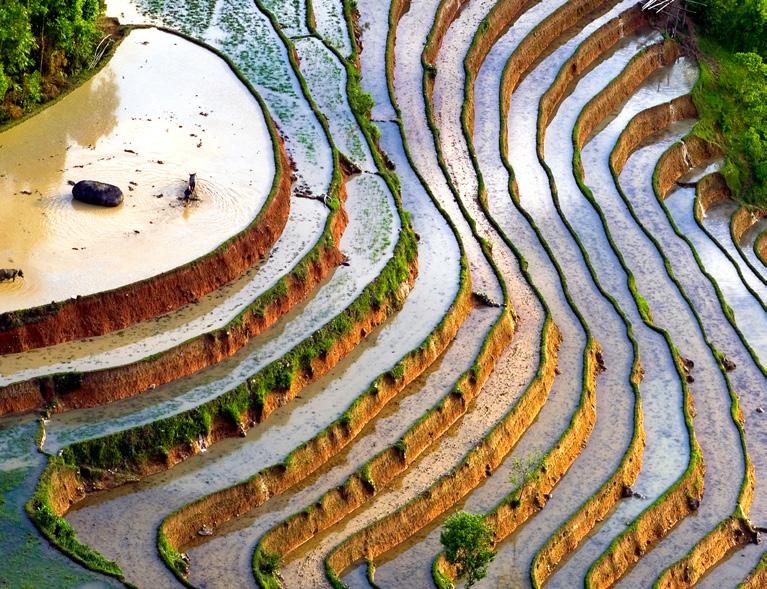
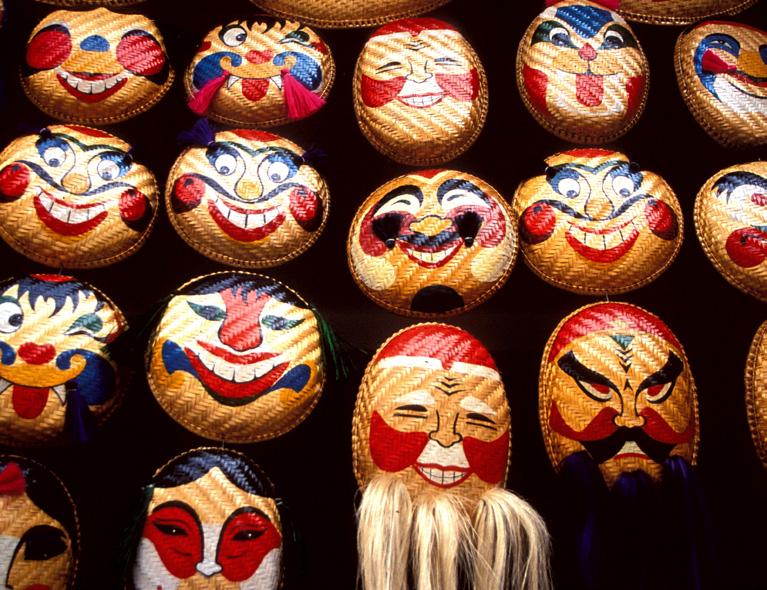
AVERAGE TEMPERATURE AND RAINFALL
In southern Vietnam the dry season lasts from December to late April or May, and the rains from May through to November; most rain falls in brief afternoon downpours, though flooding can cause problems in the Mekong Delta and central highlands. Daytime temperatures in the region rarely drop below 20°C, occasionally hitting 40°C during the hottest months (March to May). The climate of the central highlands generally follows the same pattern, though temperatures are cooler, especially at night.
Along the central coast the rainfall pattern reverses under the influence of the northeast monsoon. Around Nha Trang the wet season is relatively short (November to December); further north, around Hue and Da Nang, the rains last a bit longer, so it pays to visit these two cities in the spring (February to May). Temperatures reach their maximum (often in the upper 30°C) from June to August, when it’s pleasant to escape into the hills. The northern stretches of this coastal region experience a shorter rainy season (peaking in September and October) and a hot, dry summer. The coast of central Vietnam is the zone most likely to be hit by typhoons, bringing torrential rain and hurricane-force winds (generally between August and November).
Northern Vietnam sees fairly chilly winters (December to March), accompanied by persistent mists that can last for several days. Temperatures then build to summer maximums, which occasionally hit 40°C between May and August, and this is also the rainy season, when heavy downpours render the low-lying delta area almost unbearably hot and sticky, and flooding is a regular hazard. In the northern mountains temperatures are considerably cooler and higher regions see ground frosts, or even a rare snowfall, during the winter.
With such a complicated weather picture, there’s no one particular season to recommend as the best time for visiting Vietnam. Overall, autumn (September to December) and spring (March and April) are probably the most favourable seasons if you’re covering the entire country.
INTRODUCTION 10
OPPOSITE FROM TOP MA PI LENG PASS; MORNING GLORY, HOI AN; SUNRISE OVER HO CHI MINH CITY
Jan Feb M ar Apr M ay Jun Jul Aug S ep Oc t N ov Dec HO CHI MINH CITY Temperature (°C) 27 28 29 30 29 29 28 28 27 27 27 27 Rainfall (mm) 15 3 13 43 221 330 315 269 335 269 114 56 DA NANG Temperature (°C) 22 23 24 27 29 30 30 30 28 26 25 23 Rainfall (mm) 102 31 12 18 47 42 99 117 447 530 221 209 HANOI Temperature (°C) 17 18 20 24 28 30 30 29 28 26 22 19 Rainfall (mm) 18 28 38 81 196 239 323 343 254 99 43 20
Author picks
From the breathtaking remoteness of the mountain communities in the north to the bustling floating markets of the Mekong, our authors travelled by bike, bus, boat and on foot to cover every corner of Vietnam for this new edition. Aside from the major sights, here are their personal picks.
Spectacular views Between Dong Van and Meo Vac in the country’s extreme north, the mountain road snakes through the Ma Pi Leng Pass, where the views down to the Nho Que River and across into China will make you gasp (p.422).
Rural life The Bong Lai Valley is a gloriously far-flung destination, 10km east of Phong Nha town, where rural life continues much as it has for generations, with a remote homestay or rustic restaurant the only concession to tourism (p.311).
Stilthouse stays The Pu Luong Nature Reserve is as yet comparatively unknown to outsiders, so you can trek amid magnificent rice terraces, help prepare a tasty dinner and bed down in a stilthouse without swarms of foreigners spoiling the experience (p.314).
Hoi An delicacies Little Hoi An has an almost bewildering selection of mouthwateringly good restaurants, but Morning Glory just about takes the biscuit. For a reasonable price you can eat your fill of superbly prepared Hoi An specialities – only this time in an elegant restaurant, rather than a kindergarten-style plastic chair (p.255).
Musical performances You will be mesmerized by ca tru, an ancient form of chamber music that is described by UNESCO as an intangible heritage, at weekly performances in Hanoi (p.379).
Saigon nights Sip a cocktail with a sunset view from one of HCMC’s venerable old hotels, then prom with the locals along newly gentrified Nguyen Hue (p.74).
Banh mi Don’t leave Vietnam without trying this quintessential street snack – a baguette filled with a choice of meats and whatever other goodies the vendor is carrying in their portable stand. Foreign travellers often end up enjoying banh mi as a proxy kebab after a night on the town (p.40).
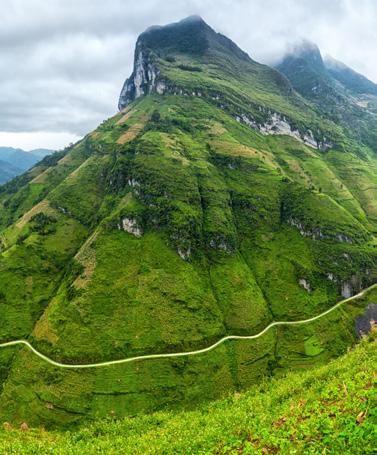
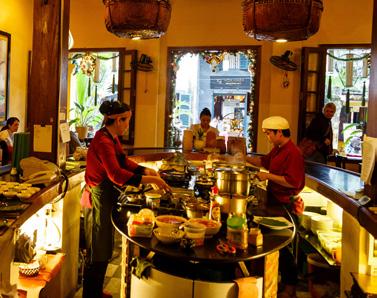
Our author recommendations don’t end here. We’ve flagged up our favourite places –a perfectly sited hotel, an atmospheric café, a special restaurant – throughout the Guide, highlighted with the ★ symbol.
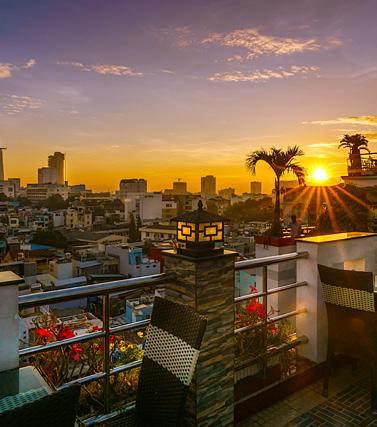
27 things not to miss
It’s not possible to see everything that Vietnam has to offer in one trip – and we don’t suggest you try. What follows, in no particular order, is a selective taste of the country’s highlights: outstanding scenery, lively festivals, ancient sites and colonial architecture. Each entry has a page reference to take you straight into the Guide, where you can find out more. Coloured numbers refer to chapters in the Guide section.
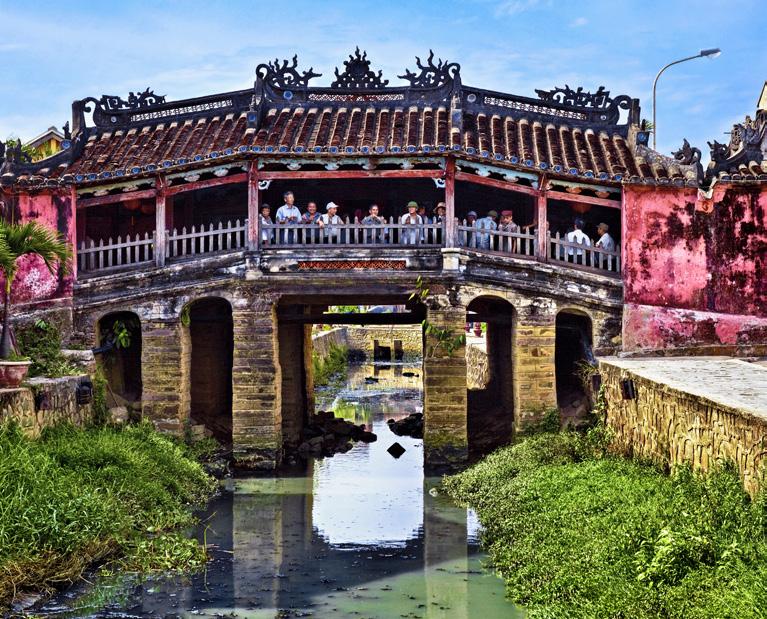
12
27 THINGS NOT TO MISS
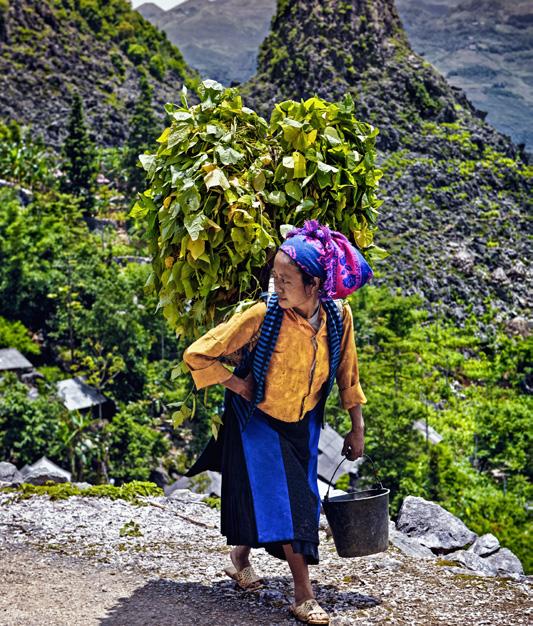
HOI AN
Page 245
With its rich cultural heritage, beautifully preserved merchants’ houses and slow pace of life, Hoi An is a captivating place to spend a few days.
DONG VAN KARST PLATEAU
GEOPARK
Page 419
Vietnam’s most impressive mountainscapes are located in remote Ha Giang province, near the Chinese border.
DA LAT
Page 172
The pretty, occasionally chilly hill-town of Da Lat is the de facto travel capital of Vietnam’s beautiful central highlands.

13
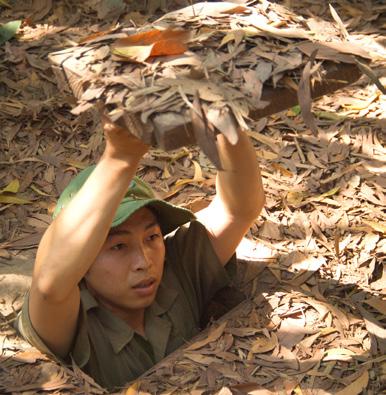





CU CHI TUNNELS & CAO DAI TEMPLE
Pages 106 & 108
So tiny are the Cu Chi tunnels that it’s hard to believe they were inhabited during the war. They’re easily visited in combination with the colourful high temple of Vietnam’s most charismatic indigenous religion.
BEER
Pages 101 & 379
Experience both sides of Vietnam’s take on beer – hit Hanoi’s bia hoi stalls for some of the world’s cheapest draught, then try some fancy ales in one of Ho Chi Minh City’s craft-beer dens.
THE CITADEL, HUE
Page 276
The former capital’s historic citadel, mausoleums and gardens are idiosyncratic enough to impress even the most jaded traveller.
WATER PUPPETS
Page 8
Enjoy a performance of mua roi nuoc, an art form developed in the Red River Delta around Hanoi.
EXPRESS SILK TAILORING
Page 256
Visit one of the many Hoi An tailors who can rustle up a made-to-measure silk dress or suit in just a few hours.
MOUNT FAN SI PAN
Page 402
Ride the record-breaking cable car from Sa Pa and stand on top of Vietnam’s highest mountain.
CHILL OUT ON PHU QUOC
Page 159
Beaches lined with coconut trees circle this holiday island, whose surrounding waters provide some of the finest snorkelling in Vietnam.
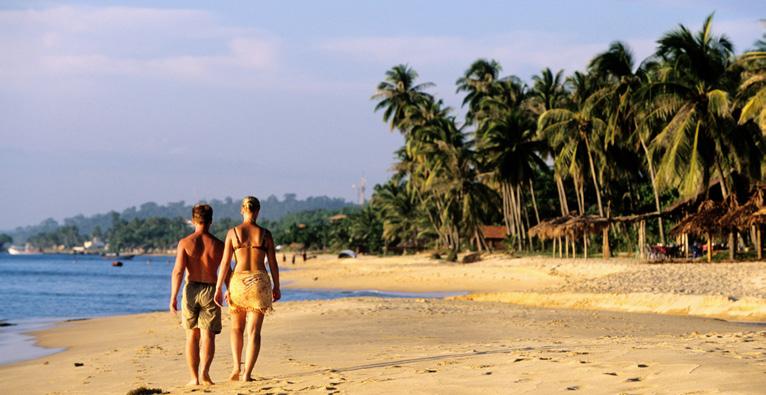
15
PO KLONG GARAI
Page 220
These beautifully preserved brick towers are probably the finest example of Cham architecture in the country.
TAM COC
Page 316
Slow the pace down with a boat trip in the countryside among dramatic karst landscapes.
ETHNIC MARKETS
Pages 404 & 405
Spectacular traditional dress and a lively atmosphere make the ethnic minority markets a must – especially those in Bac Ha and Can Cau.
CYCLING AROUND CHAU DOC
Page 131
This is the way to enjoy the Mekong Delta – pedalling between rice fields on the cusp of Cambodia, surrounded by classic Vietnamese scenery.
HOP ON A HONDA
Page 178
Vietnam has almost as many motorbikes as people, and if you can’t beat them, join them – take an “Easy Rider” tour, rent one or take a ride on a xe om.

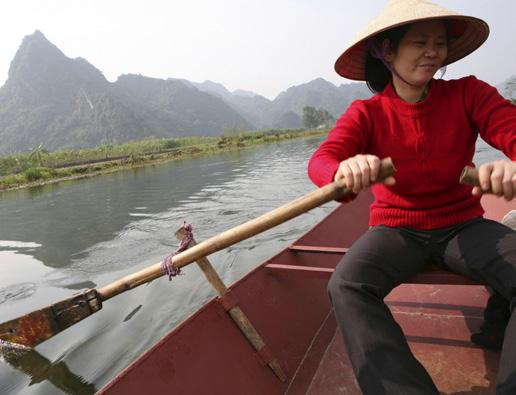
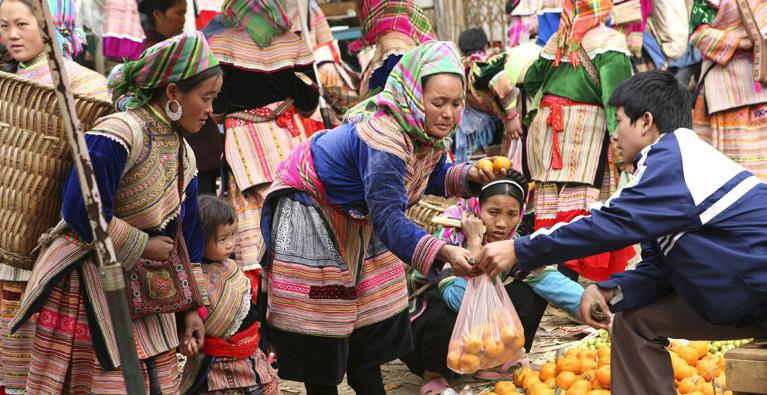
16
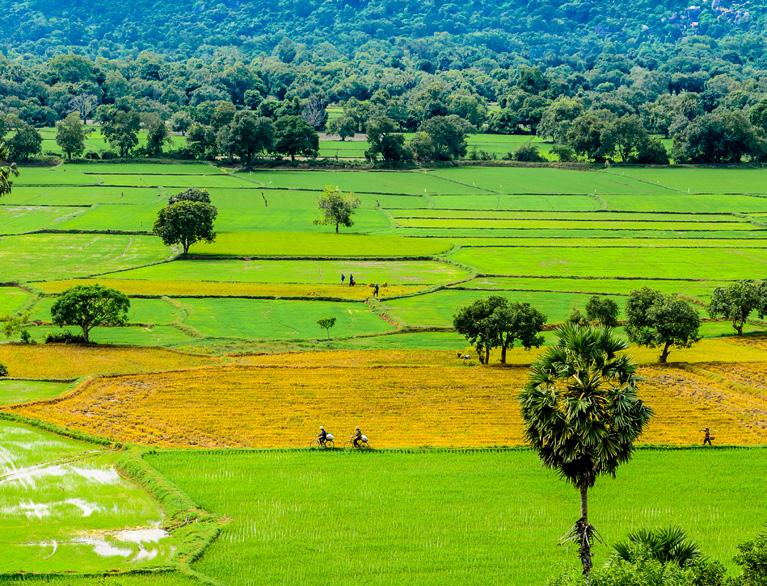
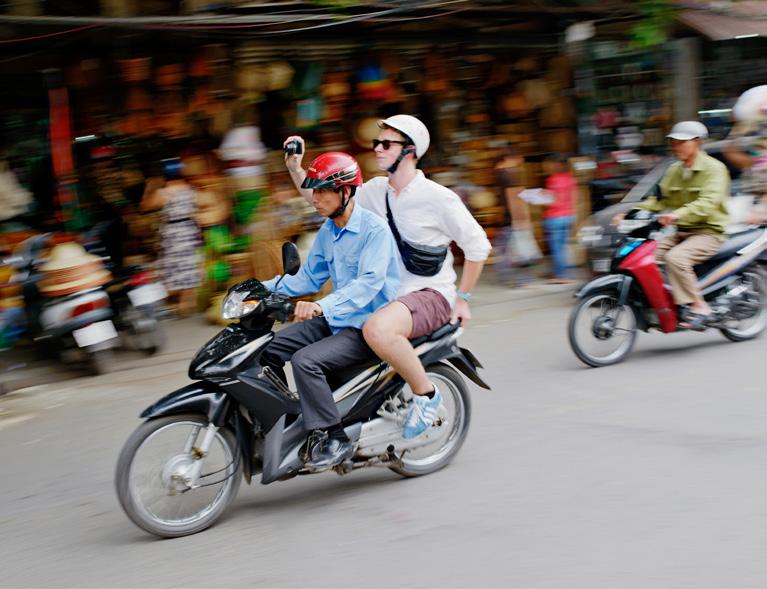
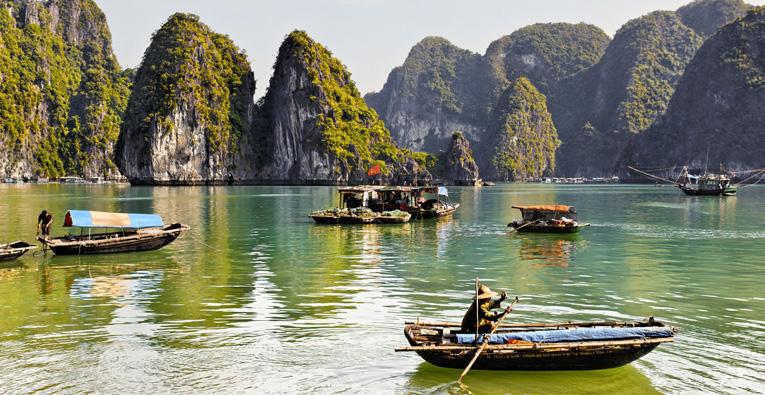
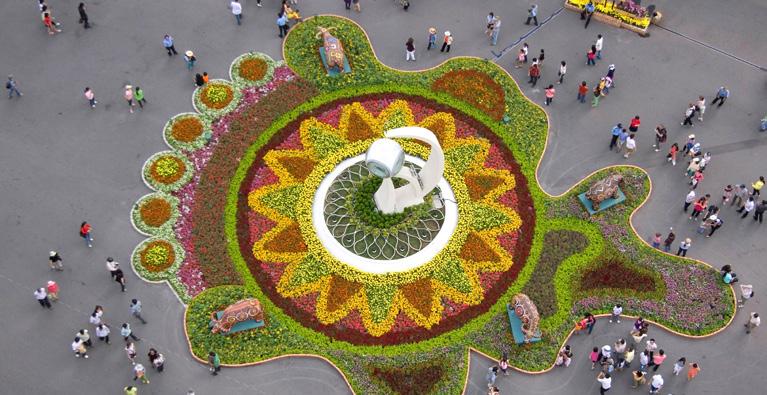



A BOAT TRIP IN HA LONG BAY
Page 337
The thousands of limestone islands jutting out of these smooth waters have been dubbed the eighth natural wonder of the world.
TET
Page 51
The most important festival in the Vietnamese calendar, Tet sees the New Year ushered in with colourful flower markets, spectacular fireworks and exuberant dragon dances.
RIDE THE REUNIFICATION EXPRESS
Page 30
Put honking bus journeys out of your mind as you kick back and relax on the leisurely train journey between Ho Chi Minh City and Hanoi.
COLONIAL ARCHITECTURE
Pages 74 & 356
The legacy of French rule can be found in umpteen impressive examples of colonial architecture, such as the opera houses in Hanoi and HCMC.
TRADITIONAL MUSIC
Page 476
Music is the most important of all Vietnam’s performing arts, and a traditional performance should feature on every itinerary.
BROWSE THE MARKETS
Page 83
Markets like Ho Chi Minh City’s Binh Tay are good stomping grounds for snacks and souvenirs alike.

19
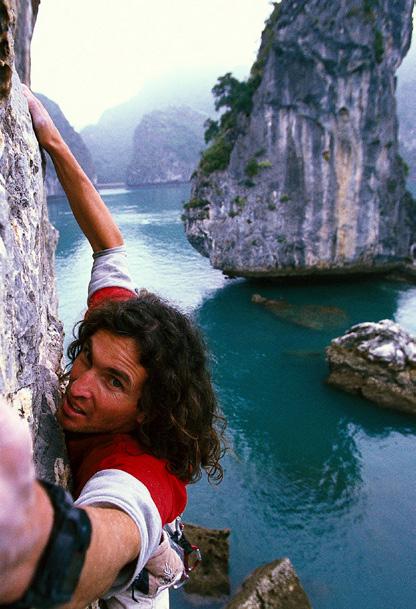

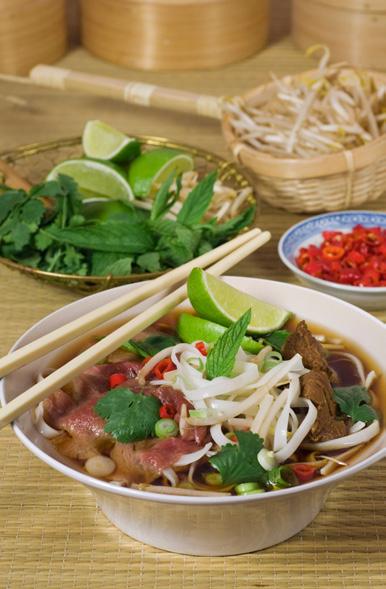


ADVENTURE SPORTS
Page 330
Kitesurfing, kayaking and mountain biking are just a few of the heart-pumping activities awaiting thrill-seekers, though rock climbing in Cat Ba is perhaps the highlight.
PHO
Page 40
Make friends with pho – usually eaten for breakfast, this is Vietnam’s slurpworthy signature dish.
BAHNAR VILLAGES
Pages 195 & 466
Spend the night in a thatched communal house (rong), where timeless ceremonies are performed and village decisions made.
THIEN MU PAGODA, HUE
Page 287
Vietnamese temples and pagodas reflect the country’s diverse range of religions: Thien Mu Pagoda in Hue is a good example.
STREET FOOD
Page 375
Soak up the atmosphere at a street kitchen, and have your plate piled high with a selection of fresh food for next to nothing – Hanoi is your best bet.
NHA TRANG
Page 223
Take a snorkelling trip in the crystalline waters of the outlying islands around Nha Trang, or simply chill out on the beach.

21

Itineraries
The following itineraries will take you right around Vietnam, combining the classic tourist sites and busy cities with laidback beaches, quiet temples and remote mountain villages, where you’d be hard-pushed to find another visitor. Don’t worry about seeing everything – each of these routes will give you a good taste of the country.
THE GRAND TOUR
The classic tour for visitors to Vietnam, and with good reason – following this route gives you easy access to superb historical sights, high-octane nightlife, pristine beaches, mountain-dwelling minority groups and much more. It can easily eat up the full month of your visa.
1 Ho Chi Minh City Although it’s not the capital, most would agree that this buzzing, cosmopolitan city is the true hub of Vietnam –its range of bars, restaurants, shops and hotels is unsurpassed. See p.64
2 Da Lat This mile-high mountain city is highly popular with travellers, and not just for its fresh air or cooler temperatures. Its relaxed atmosphere lends itself to a leisurely exploration of nearby sights, which include some wonderful minority villages. See p.172
3 Mui Ne It’s all about the beach at Mui Ne, a curl of sand now fringed with top-drawer resorts. Even so, there are still a few cheap places to stay and a couple of bars maintaining that old-fashioned backpacker vibe. See p.2123
4 Nha Trang Another place famed for its beach life, but with a totally different character. This is one of Vietnam’s party capitals, with bars galore attracting revellers with astonishingly long happy hours. Those who wake up before nightfall can hit the nearby Cham ruins, then sink into a mud bath. See p.223
5 Hoi An This small city draws almost universally positive reactions from visitors. Its food is the best in the country, its lantern-lit buildings are truly spellbinding at night, the nearby sea is great for diving and the majestic Cham ruins of My Son are close by. See p.245
6 Hue Notably relaxed for its size, Hue was the capital of Vietnam’s last dynasty, the Nguyen empire. Cross the Perfume River to the old Imperial City, a maze of opulent buildings that were home to emperors as recently as 1945. See p.274
7 Hanoi The Vietnamese capital provides a truly startling contrast to Ho Chi Minh City, with a far more traditional air and some superb examples of colonial-era architecture. That said, its bars and restaurants are excellent too. See p.342
8 Ha Long Bay There are few better ways to round off a Vietnamese tour than with a trip to Ha Long Bay, a dizzying mass of limestone peaks jutting from the sea. Most visitors spend a night at sea on a wooden junk after a feast of seafood and cocktails. See p.336
UNSEEN MEKONG DELTA
Eager to leave the tourist hordes behind? You’ll rarely spot another foreigner at the following locations, and the whole lot can be seen in the space of a week.
ITINERARIES 22
ABOVE KHAI DINH MAUSOLEUM
1 Sa Dec flower nurseries Apart from being the former home of French novelist Marguerite Dumas, Sa Dec is the base of over a hundred flower nurseries – a horticulturalist’s dream. See p.129
2 Hang Pagoda near Tra Vinh This Khmer-style pagoda, painted in subtle pastel shades, is home to hundreds of storks roosting in the treetops. See p.124
3 Ca Mau Peninsula Hit Vietnam’s southernmost point, where an observation tower offers views over mangrove swamps and the endless ocean. See p.148
4 Highway 63 This narrow road from Ca Mau to Rach Gia passes classic delta scenes of commerce being conducted on canals and locals crossing precarious monkey bridges. See p.151
5 Tra Su Bird Sanctuary Located near Chau Doc, this bird sanctuary is a wonderland of cajuput trees and waterways covered with lily pads, which attract flocks of birds like egrets, cormorants and water cocks. See p.134
6 Hon Chong Peninsula The beach doesn’t compare with those on Phu Quoc, but it’s perfect on weekdays when you might be the only one swinging in a hammock beneath the casuarina trees. See p.158
ETHNIC CULTURE TOUR
Most of Vietnam’s 54 ethnic minority groups live in the rugged hills of the north, and a circular journey from Hanoi passes several of the most interesting groups. It’s possible to get around the north in a week, though a fortnight would allow more time for relaxing.
1 White Thai in Mai Chau Women with waist-length hair don traditional costumes and perform lively song and dance routines, then invite guests to share a huge jar of rice wine. See p.414
2 Black Thai in Son La The most remarkable aspect of Black Thai clothing is the headdress, which features delicately embroidered panels. See p.411
3 Red Dao near Sa Pa Easily spotted by their bright red headgear, the Red Dao are one of the most colourful tribes in the north and cling fiercely to their traditional ways. See p.401
THAILAND
CHINA
GULF OF TONKIN
UNSEEN MEKONG DELTA
ETHNIC CULTURE TOUR
CAMBODIA
GULF OF THAILAND
SOUTH CHINA SEA
SEA
4 Flower Hmong around Bac Ha These are hands down the north’s most flamboyant dressers, and the women are constantly looking for new accoutrements at local markets. See p.403
5 White Hmong near Dong Van Satins and sequins are highly favoured by this group, who live in one of the north’s most inhospitable, yet also stunningly scenic, settings. See p.419
6 Tay near Ba Be Lake The Tay are the most numerous of all ethnic groups in Vietnam, and have a rich tradition of song and dance, which they occasionally perform for tourists. See p.423
1 2 3 4 5 1 2 3 4 5 6 6 1 2 3 4 5 6 7 8 ITINERARIES 23
EAST
LAOS THE GRAND TOUR

25 Getting there 28 Visas and entry requirements 29 Getting around 36 Accommodation 38 Food and drink 45 Health 47 The media 48 Crime and personal safety 50 Festivals and religious events 52 Sports and outdoor activities 54 Shopping 55 Travelling with children 56 Travel essentials Basics
CYCLIST IN HO CHI MINH CITY
Getting there
The number of international flights heading to Vietnam has been steadily increasing of late – a fair sign of the country’s burgeoning popularity as a tourist destination. The vast majority of visitors fly into Ho Chi Minh City and Hanoi, though there are also direct services to Da Nang, Hai Phong, Nha Trang and Phu Quoc from other (largely Asian) destinations. However, a fair chunk of visitors still take the cheaper option of an indirect flight routed through Bangkok, Singapore or Hong Kong; a stay in one of these cities can be factored into your schedule, often at no extra cost.
You may well save even more by taking a bargain-basement flight to Bangkok, Kuala Lumpur or Singapore, and a separate ticket through one of the region’s low-cost carriers, such as Jetstar (W jetstar.com) and AirAsia (W airasia.com), for the Vietnam leg.
Major long-haul airlines usually fly in and out of both Hanoi and Ho Chi Minh City; they can sometimes sell you an open-jaw ticket, which allows you to fly into one city and out of the other, leaving you to travel up or down the country under your own steam. Vietnam Airlines (W vietnamairlines.com) is the national flag-carrier, and currently flies to over fifty destinations in almost twenty countries; it’s a quality operator, and part of the SkyTeam group.
Airfares always depend on the season, with the highest generally being July to August, during the Christmas and New Year holidays and around Tet, the Vietnamese New Year; fares drop during the shoulder season (September to mid-December) and the low season (January to June), when you’ll get the best prices.
You can often cut costs by going through a specialist flight agent – either a consolidator, who buys up blocks of tickets from the airlines and sells them at a discount, or a discount agent, who in
addition to dealing with discounted flights may also offer special student and youth fares and a range of other travel-related services such as travel insurance, rail passes, car rentals, tours and the like.
Lastly, combining Vietnam with other Southeast Asian countries is becoming increasingly popular –and a lot cheaper and easier – thanks to some good-value regional air deals (see p.29 for more information).
Flights from the UK and Ireland
Vietnam Airlines (W vietnamairlines.com) flies from London to Ho Chi Minh City and Hanoi (both around 12hr); there are no direct flights from Ireland. Note that you may save money by flying with a Middle Eastern or Southeast Asian carrier such as Qatar (W qatarairways.com), Emirates (W emirates.com), Malaysia Airlines (W malaysiaair lines.com) or Singapore Airlines (W singaporeair .com), via the airline’s hub city; scheduled low-season return fares from London start at just over £400, rising to £700 or more at peak periods.
A good place to look for the best deals is the travel sections of the weekend newspapers and in regional listings magazines. Students and under-26s can often get discounts through specialist agents such as STA (W statravel.co.uk) or USIT in Ireland (W usit.ie). Whoever you buy your ticket through, check that the agency belongs to the travel industry bodies ABTA or IATA, so that you’ll be covered if the agent goes bust before you get your ticket.
Flights from the US and Canada
Amazingly, no direct flights exist between Vietnam and North America – studies have shown that LA to Ho Chi Minh City is the busiest air route in the world lacking a direct service. In 2004, United Airlines (W united.com) broke a flight embargo in place since 1975, but their service (which ran via Hong Kong) was discontinued in 2016; at the time of research, Vietnam Airlines (W vietnamairlines .com) were clearing the regulatory hurdles necessary to make their first-ever foray into US
A BETTER KIND OF TRAVEL
At Rough Guides we are passionately committed to travel. We believe it helps us understand the world we live in and the people we share it with – and of course tourism is vital to many developing economies. But the scale of modern tourism has also damaged some places irreparably, and climate change is accelerated by most forms of transport, especially flying. All Rough Guides’ flights are carbon-offset, and every year we donate money to a variety of environmental charities.
GETTING THERE BASICS 25
airspace. Until then, you’ll have to catch one of the many flights to a regional hub (such as Bangkok, Singapore or Hong Kong), and continue from there. Scheduled return flights starting from New York or Los Angeles can dip under US$600 if you’re in luck (though be prepared to pay double this), while fares bottom out at around CAN$900 from Vancouver and CAN$1300 from Toronto (again, it’s usually double).
Note that some routes require an overnight stay in another city, and often a hotel room will be included in your fare – ask the airline and shop around, since travel agents’ policies on this vary. Even when an overnight stay is not required, going to Vietnam can be a great excuse for a stopover somewhere: many airlines will allow you one free stopover in either direction.
Flights from Australia and New Zealand
Direct flights between Australia and Vietnam are in surprisingly poor supply, with Vietnam Airlines (W vietnamairlines.com) operating routes from Ho Chi Minh City to Melbourne and Sydney (both 8–9hr). One reason for the dearth of direct services has been the profusion of far cheaper alternate routes, making use of the region’s many budget airlines – you can fly AirAsia (W airasia.com), Cebu Pacific (W cebupacificair.com) or Jetstar (W jetstar .com) all the way via Southeast Asia, with one-way prices starting at around AUS$200. The resulting competition means that you can often get decent deals on “proper” airlines, with tickets on Malaysia Airlines (W malaysiaairlines.com), Singapore Airlines (W singaporeair.com) and Thai Airways (W thaiair ways.com) via Bangkok all costing AUS$1100–1500 if you book at the right time of year.
There are no direct flights from New Zealand, and budget-airline options are a little more restrictive; AirAsia (W airasia.com) fly from Auckland to Kuala Lumpur and thence to Vietnam (from as little as NZ$350 one-way), but you’ll often get cheap-as routings via Australia too. As for flag carriers, low-season fares with Malaysia Airlines, Thai Airways, Qantas (W qantas.com) and Singapore Airlines all start at around NZ$1500–2200 return.
Flights from neighbouring countries
Regional air connections are becoming better and better – you can fly from many cities in
Cambodia, Laos, Malaysia and Thailand, while options are also profuse from South Korea, Japan and mainland China. Budget options are increasing every year: from Singapore you can choose from Jetstar (W jetstar.com), Scoot (W flyscoot.com), Silk Air (W silkair.com) and Vietjet Air (W vietjetair.com), and from Bangkok you can try AirAsia (W airasia.com), Jetstar, Lion Air (W lionairthai.com), Nok Air (W nokair.com) or Vietjet – and there are also plenty of options from Kuala Lumpur. As with all discount airlines, prices depend on availability, so the earlier you book the better – prices can start as low as US$20. Otherwise, you’re dependent on flag carriers such as Cambodia Angkor Air (W cambodiaangkorair.com) and Lao Airlines (W laoairlines.com), though Vietnam Airlines (W vietnamairlines.com) occasionally offers some competitive deals.
Overland
It’s simple to enter Vietnam overland from China, Laos or Cambodia, and this option means you can see more of the region than you would if you simply jetted in.
At the time of research, the border in China was open to foreigners at Lao Cai (see p.398), Thanh Thuy near Ha Giang (see p.417), Dong Dang near Lang Son (see p.427) and Mong Cai (see p.333). Direct train services to Hanoi (39hr) leave Beijing on Thursdays and Sundays at 3.45pm, though these days it’s easy to get a highspeed train from more or less anywhere in China to the southern city of Nanning, and then catch the daily 6.10pm service to Hanoi (11hr). Note that only soft-sleeper tickets are available on these cross-border trains, and that if travelling to China from Vietnam you can board the train only in Hanoi. Always bring your passport when buying tickets.
From Laos, six border crossings are currently open to foreigners: Lao Bao (see p.301), the easiest and most popular, some 80km west of Dong Ha; Cau Treo and Nam Can, to the north and northwest of Vinh (see p.313); Na Meo, northwest of Thanh Hoa (though this isn’t worth the hassle); Tay Trang, just west of Dien Bien Phu (see p.410); and Bo Y, northwest of Kon Tum (see p.196). While it’s perfectly possible – and cheaper – to use local buses to and from the borders, international bus services also run from Savannakhet and Vientiane to Hanoi, Dong Ha, Vinh, Da Nang and other destinations in Vietnam;
BASICS GETTING THERE 26
these direct services are recommended, as reports of extortion or unnecessary difficulties continue to come in from those crossing independently.
From Cambodia you can travel by air-conditioned bus from Phnom Penh straight through to Ho Chi Minh City, via the Moc Bai crossing. Cheaper operators tend to use old buses and usually get you to switch at the border. Many tour companies in Phnom Penh or Ho Chi Minh City will be able to organize boat-plus-bus services, which are a fun way to make the trip (see p.88).
There are two crossings in the Mekong Delta area – Vinh Xuong and Tinh Bien – which are respectively 30km north and 25km west of Chau Doc. There are also border crossings at Xa Xia, on the coast west of the delta, which is useful if you are heading to or from Kampot, Kep or Sihanoukville on the Cambodian coast, and at Le Thanh in the central highlands, making it possible to go from Banlung in northeast Cambodia straight through to Pleiku.
As long as you have a valid visa, crossing these borders is generally not a problem, though you may still find the odd Vietnamese immigration official who tries to charge a “processing fee” (typically $1); on the Cambodian side, this bribe is usually around $5. Most border gates are open from around 7am to 5pm, and they may close for an hour over lunch.
SPECIALIST TOUR OPERATORS ABROAD WORLDWIDE
Abercrombie & Kent UK T 01242 547 760, US T 1 800 554 7016, Australia T 1300 797 010; W abercrombiekent.co.uk. Luxury tour specialist; trips featuring Vietnam come as part of a greater trip through Indochina.
Backyard Travel International freephone T 800 2225 9273, W backyardtravel.com. Though based in Bangkok, these Asia specialists certainly know the ropes in Vietnam, with tours focusing on everything from Hanoi street food and cultural experiences to “the footsteps of Marguerite Duras” (see p.129), as well as the usual pan-country trips.
Intrepid Travel UK T 0808 274 5111, US T 1 800 970 7299, Australia T 1300 364 512, New Zealand T 0800 600 610; W intrepidtravel.com. Affordable small-group trips, usually focusing on low-impact, cross-cultural contact. Tours can cover bits of Vietnam, the whole country or wider Indochina.
Peregrine Adventures UK T 0845 004 0673, Australia T 3 8601 4444; W peregrineadventures.com. Good local knowledge for an outfit that goes everywhere. Most tours are small-group and adventure-based, often with a focus on trekking, cycling or even food.
STA Travel UK T 0800 819 9339, US T 1 800 781 4040, Australia T 134 782, New Zealand T 0800 474 400, South Africa T 0861 781 781; W statravel.com. Worldwide specialists in independent travel, student IDs, travel insurance, car rental, rail passes and more. Good discounts for students and under-26s.
World Expeditions UK T 020 8545 9030, US & Canada T 1 800 567 2216, Australia T 1300 720 000, New Zealand T 0800 350 354; W worldexpeditions.com. Adventure company with a wide variety of programmes, including cycle tours from Hue to Ho Chi Minh City, and kayaking in Ha Long Bay. Also offers community project trips, where participants help renovate a local school, for example, and arrange charity challenges.
AUSTRALIA AND NEW ZEALAND
Griswalds Vietnamese Vacations Australia T 02 9430 6426, W vietnamvacations.com.au. Long-running Vietnam specialist offering small-group, tailor-made itineraries – the website still looks a bit mid-1990s, but the tours are top-notch.
UK AND IRELAND
Exodus UK T 0845 287 7644, W exodus.co.uk. Adventure-tour operator taking small groups on specialist programmes that take in trekking, biking, kayaking and cultural trips.
G Adventures UK T 0344 272 2060, W gadventures.co.uk. There are plenty of cross-Vietnam and wider Indochina tours on offer from this well-regarded operator – some include hiking, biking and kayaking. Imaginative Traveller UK T 0845 287 2855, W imaginative -traveller.com. Affordable, small-group adventure tours from a responsible travel operator – their food-based tours are particularly interesting.
InsideVietnam UK T 0117 370 9758, W insideasiatours.com. Well-run small-group or tailored individual packages from an operator now expanding its scope across Asia. Their ten-night highlights tour is a popular option.
Regent Holidays UK T 020 3131 6202, W regent-holidays .co.uk. Any operators that can organize good tours to North Korea will surely find Vietnam a piece of cake. Good-value, tailor-made tours available, as well as off-the-shelf itineraries like the twelve-day “Highlights of Vietnam” trip.
US AND CANADA
Artisans of Leisure T 1 800 214 8144, W artisansofleisure.com
Luxury private and individually tailored tours, which often include cooking classes and spa therapy sessions.
Backroads T 1 800 462 2848, W backroads.com. Cycling and hiking linking Vietnam and Cambodia, with the emphasis on going at your own pace.
Journeys International T 1 800 255 8735, W journeys international.com. Prestigious, award-winning operator focusing on ecotourism and small-group trips.
VeloAsia T 1 888 681 0808, W veloasia.com. Indochina specialist with a range of organized and tailor-made cycling adventure tours. Their famed 12-day “Highlights of Vietnam” tour connects Hanoi and Ho Chi Minh City.
GETTING THERE BASICS 27

















































